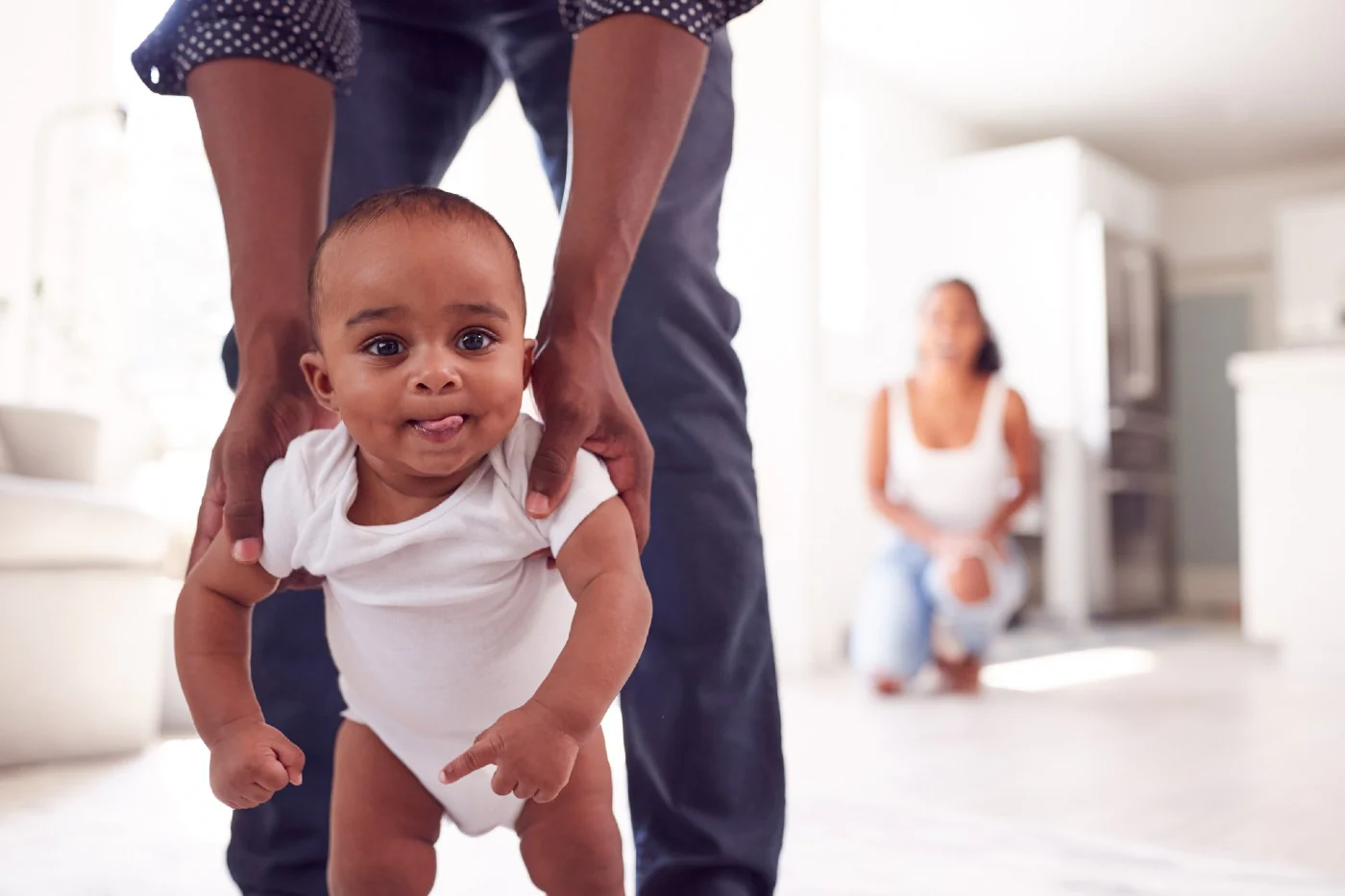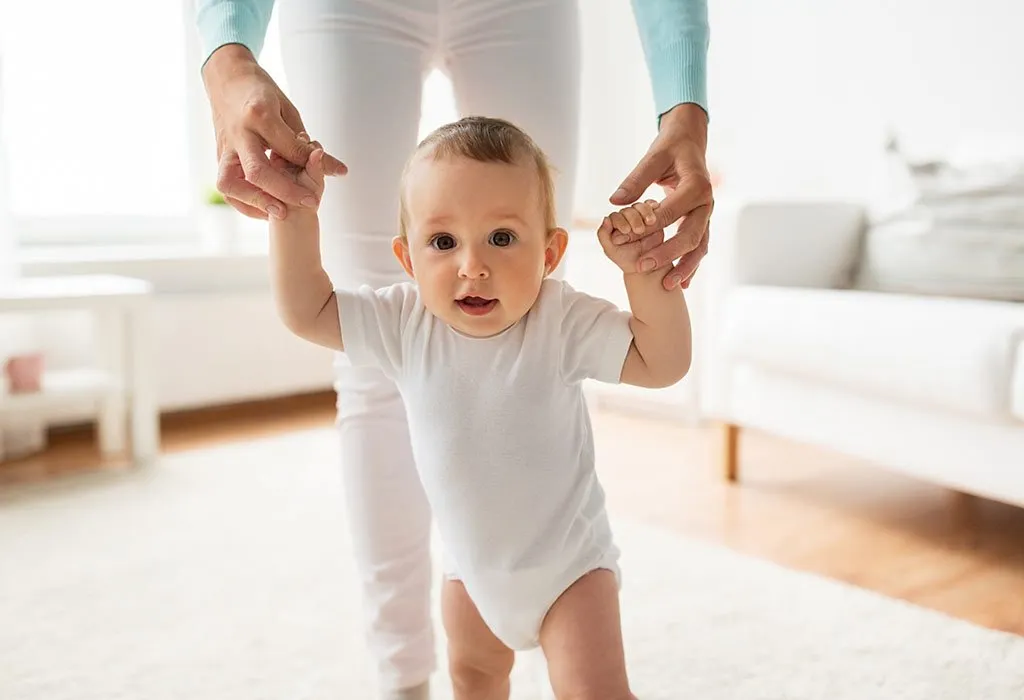Seeing your little one start to stand is a thrill like no other, isn’t it? Most babies take their first steps toward standing with support between 9 and 12 months. This range isn’t set in stone, as various factors influence baby development, such as their motor skills and physical strength.
Look out for signs of readiness, like when they pull up on furniture.
It’s all part of their natural developmental timeline.
Creating a safe spot for them to practice standing is really important. Having sturdy furniture nearby and your encouraging presence can make a world of difference in building their confidence.
Understanding Infant Milestones For Standing
It’s truly heartwarming to witness your little one making strides toward their developmental achievements. Generally, many babies begin their journey toward a standing position between 9 to 12 months.
They often rely on furniture for support, using sturdy playpens or baby furniture to help steady themselves.
Keep an eye out for those adorable squats; they’re a sign that your baby is building their leg strength! Creating a safe space with soft surfaces and a safety harness allows them to practice standing without fear. Each child progresses at their own pace, so savor every moment of this joyful adventure while providing them with supportive standing options, safe baby furniture, and playpens that encourage exploration with a safety harness.
Baby Development Stages And Their Importance
Every little moment in your baby’s life contributes to their amazing growth journey. These fascinating phases help shape their skills and confidence.
From learning to sit, crawl, and eventually stand, each segment plays an important role in their overall progress.
During these times, your little one practices their gross motor skills, building strength and balance through playful exploration.
It’s truly rewarding to witness your baby reach these significant milestones. Utilizing tools like baby walkers can offer the support they need for those early attempts at standing, making the process both fun and safe.
Encouraging Early Walking With Supportive Standing
Watching your little one take their first steps brings such joy, doesn’t it? Supportive environments make all the difference when it comes to developing those standing skills. Creating a safe space encourages your baby to practice balancing while building muscle strength.
Soft surfaces, like rugs, along with sturdy furniture provide the perfect setting for them to pull up and explore their surroundings.
You might also consider some fun baby gear designed for this stage, such as activity centers.
As your baby engages with interactive toys, they’ll be thrilled while honing their stability. Each attempt, no matter how small, boosts their growth and confidence, leading them towards more exciting motor skills ahead, supported by parental guidance, the right baby gear, and activities that enhance balance training, muscle strength, and stability.
Exploring Motor Skills For Baby Development
Watching your little one as they explore their surroundings can be a delightful experience. These early stages are packed with opportunities for them to enhance their abilities and engage in playful exploration.
Infants start to develop coordination when they learn to roll over and crawl, paving the way for those exciting age milestones like standing and walking.
You can support their growth by encouraging activities such as tummy time and reaching for toys.
These moments not only motivate movement but also help build strength. Keeping an eye on their progress allows you to assess motor skill advancements effectively.
Just remember, each baby has their own rhythm, so stay tuned to their readiness.
As your baby progresses toward standing, offering physical support can be incredibly beneficial. By being there to help them stand, you create an encouraging environment that fosters their confidence. This support system makes stepping into those first wobbly steps feel like an exciting journey of playful exploration, guided by pediatric advice, encouragement, and the joy of reaching important age milestones.
Infant Development
- Tummy time helps strengthen neck, shoulder, and back muscles essential for crawling and walking.
- Infants typically roll over by around 4-6 months and begin crawling by 6-10 months.
- Encouraging reaching for toys promotes hand-eye coordination and fine motor skills.
- Each baby develops at their own pace, with milestones like standing and walking occurring between 9-15 months.
Safety Tips For Using Baby Gear
Keeping your little one safe while they explore the world around them is a top priority for every parent. Using the right gear not only enhances their safety but also supports healthy development during these exciting milestones.
Choosing the Right Gear: Look for sturdy items that come with reliable safety features.
Always check the weight limits to ensure they match your baby’s size for crawling support.
Supervision is Key: When they’re using standing aids, keep a watchful eye. No piece of gear can replace attentive parenting, especially during those important moments of sensory exploration.
Setting Up for Success: Make sure to choose a safe space, free from hazards. As your baby practices standing, cheer them on—this is their tummy time!
Recognizing Comfort is essential for promoting baby safety and healthy development, as it supports crawling and encourages sensory exploration.
How To Use Standing Frames Effectively
Utilizing a supportive frame can make a real difference in how your little one experiences their journey through growth and exploration. Start by checking for signs of readiness, such as the ability to hold their head up or a natural curiosity about standing.
These indicators help pave the way for a successful experience!
Once you’re ready, find a secure spot for the frame.
Allow your baby to freely explore and engage in physical activity while honing their balance.
It’s an exciting opportunity for them to build confidence and gain early independence. Keep things light-hearted and enjoyable, and you’ll be amazed at how quickly your child learns new positions and skills.
As you guide them, remember to offer encouragement and celebrate their milestones, fostering a positive atmosphere.
After ensuring safety measures are in place with your baby gear, the next step is to introduce engaging activities. This combination fosters a well-rounded approach to child development that encourages early independence through physical activity, support systems, and social interaction.
Child Development
- Babies typically show signs of readiness for movement, such as holding their head up, around 4 to 6 months of age.
- Engaging in physical activities helps improve a child’s balance and coordination, crucial for their motor skill development.
- Positive reinforcement and encouragement can significantly enhance a child’s confidence and willingness to explore new skills.
- Social interaction during playtime contributes to emotional and cognitive development, promoting early independence.
Engaging Baby In Playtime For Balance Training
Playtime offers a wonderful opportunity for your baby to develop balance skills while having a blast. As they engage in fun activities, you might notice how these balancing games line up with important milestones on their growth charts.
Interactive activities encourage your little one to shift their weight and explore their capabilities, which is so exciting to watch! Standing toys can be especially helpful, motivating them to reach and stretch, enhancing their stability as they play.
Just make sure the play area is safe—soft surfaces and baby-proofing are your best friends during these learning moments.
Getting involved during play is super important.
Simple communication can really boost their learning experiences and foster exploration. Keep an eye out for signs that hint your baby is ready for new challenges. If you’re ever unsure, don’t hesitate to ask your pediatrician for advice on fun activities that will support their development, especially when considering milestone charts, developmental delays, health checkups, and the use of standing toys.
Parent Involvement In Baby’s Physical Development
Being involved in your baby’s life opens up a world of possibilities for their physical growth. Engaging with them during playtime transforms simple moments into opportunities for strength building and exploration.
Think about how impactful it is when you gently support them while they learn to stand or take their first steps.
By participating in various activities, you’re helping your baby discover how their body moves and gains confidence in those abilities.
Every little achievement is worth celebrating, turning each moment into a joyful experience that encourages more active play. These interactions not only nurture their development but also strengthen the bond you share.
As you continue to explore engaging activities with your little one, keep the focus on fun and connection.
From rolling a ball to dancing in the living room, these moments are all about strength building through laughter and joy. Each game and giggle will pave the way for meaningful playtime, boosting engagement, strength building, and parent involvement through active play.
Baby Development Through Play
- Engaging in physical activities with your baby enhances their motor skills and coordination.
- Celebrating small achievements boosts a child’s self-esteem and encourages further exploration.
- Interactive play fosters emotional bonding between parents and their babies, promoting secure attachment.
- Active playtime contributes to overall physical health and encourages lifelong habits of movement and fitness.
Conclusion
Reflecting on your journey with your little one, it’s fascinating to see how much your presence plays a role in their physical development. As they grow, recognizing those important milestones can truly enhance their exploration skills.
Supporting their journey to the upright position is key, and your active participation encourages confidence.
Take a moment to consider if you’re providing enough opportunities for practice with mobility aids.
Look at your daily routines and think about how you can create a nurturing environment that promotes movement.
Each baby is unique, so celebrate their individual path. Here’s to all the wonderful milestones waiting just around the corner, supported by exploration skills, safety tips, a nurturing environment, mobility aids, and maintaining an upright position.
Originally posted 2025-03-21 12:29:11.




